What is Supply Chain Management? The basics, process
VerifiedAdded on 2022/08/22
|13
|2895
|52
AI Summary
Contribute Materials
Your contribution can guide someone’s learning journey. Share your
documents today.
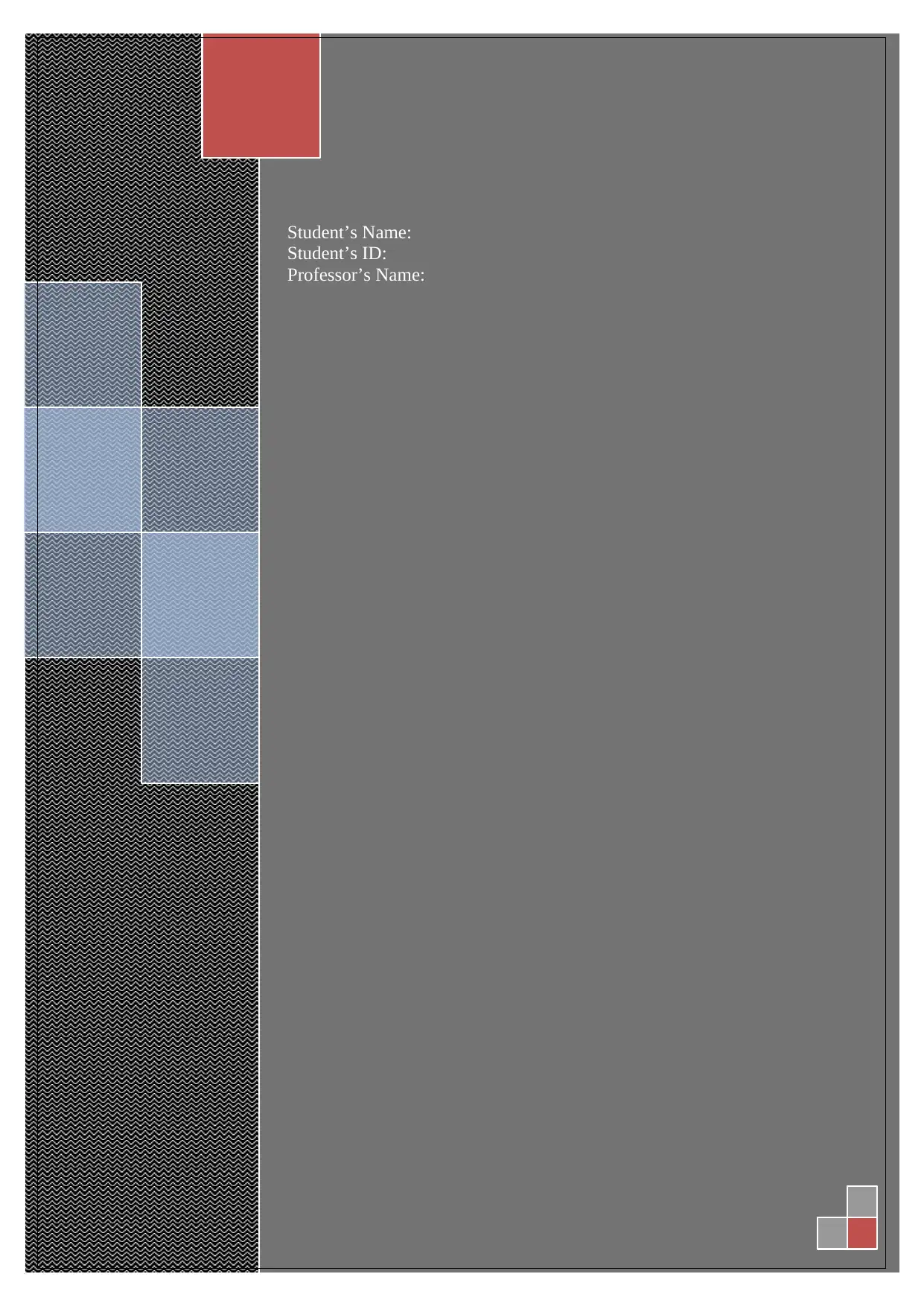
Student’s Name:
Student’s ID:
Professor’s Name:
Student’s ID:
Professor’s Name:
Secure Best Marks with AI Grader
Need help grading? Try our AI Grader for instant feedback on your assignments.
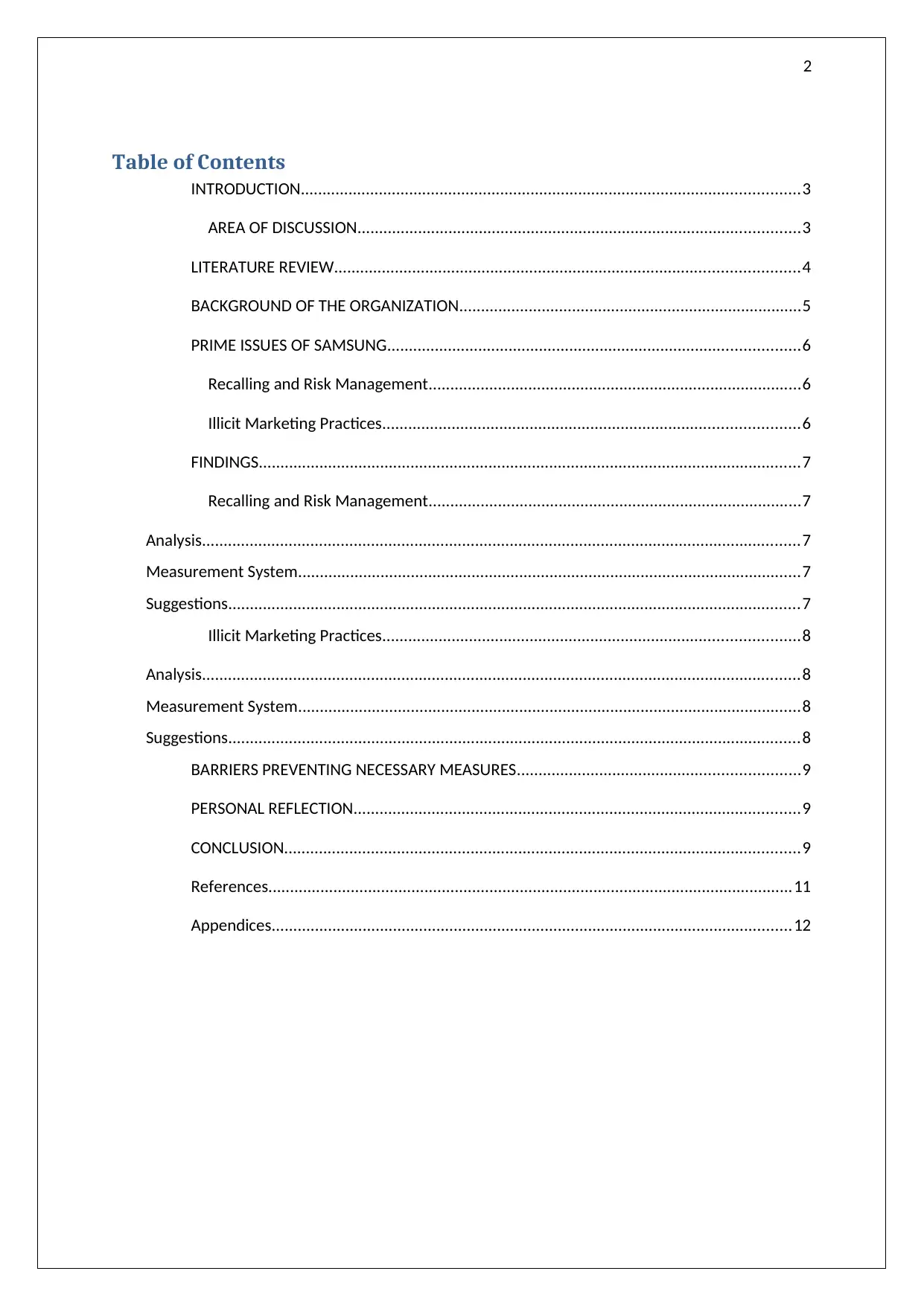
2
Table of Contents
INTRODUCTION...................................................................................................................3
AREA OF DISCUSSION......................................................................................................3
LITERATURE REVIEW...........................................................................................................4
BACKGROUND OF THE ORGANIZATION...............................................................................5
PRIME ISSUES OF SAMSUNG...............................................................................................6
Recalling and Risk Management......................................................................................6
Illicit Marketing Practices................................................................................................6
FINDINGS.............................................................................................................................7
Recalling and Risk Management......................................................................................7
Analysis..........................................................................................................................................7
Measurement System....................................................................................................................7
Suggestions....................................................................................................................................7
Illicit Marketing Practices................................................................................................8
Analysis..........................................................................................................................................8
Measurement System....................................................................................................................8
Suggestions....................................................................................................................................8
BARRIERS PREVENTING NECESSARY MEASURES.................................................................9
PERSONAL REFLECTION.......................................................................................................9
CONCLUSION.......................................................................................................................9
References.........................................................................................................................11
Appendices........................................................................................................................12
Table of Contents
INTRODUCTION...................................................................................................................3
AREA OF DISCUSSION......................................................................................................3
LITERATURE REVIEW...........................................................................................................4
BACKGROUND OF THE ORGANIZATION...............................................................................5
PRIME ISSUES OF SAMSUNG...............................................................................................6
Recalling and Risk Management......................................................................................6
Illicit Marketing Practices................................................................................................6
FINDINGS.............................................................................................................................7
Recalling and Risk Management......................................................................................7
Analysis..........................................................................................................................................7
Measurement System....................................................................................................................7
Suggestions....................................................................................................................................7
Illicit Marketing Practices................................................................................................8
Analysis..........................................................................................................................................8
Measurement System....................................................................................................................8
Suggestions....................................................................................................................................8
BARRIERS PREVENTING NECESSARY MEASURES.................................................................9
PERSONAL REFLECTION.......................................................................................................9
CONCLUSION.......................................................................................................................9
References.........................................................................................................................11
Appendices........................................................................................................................12
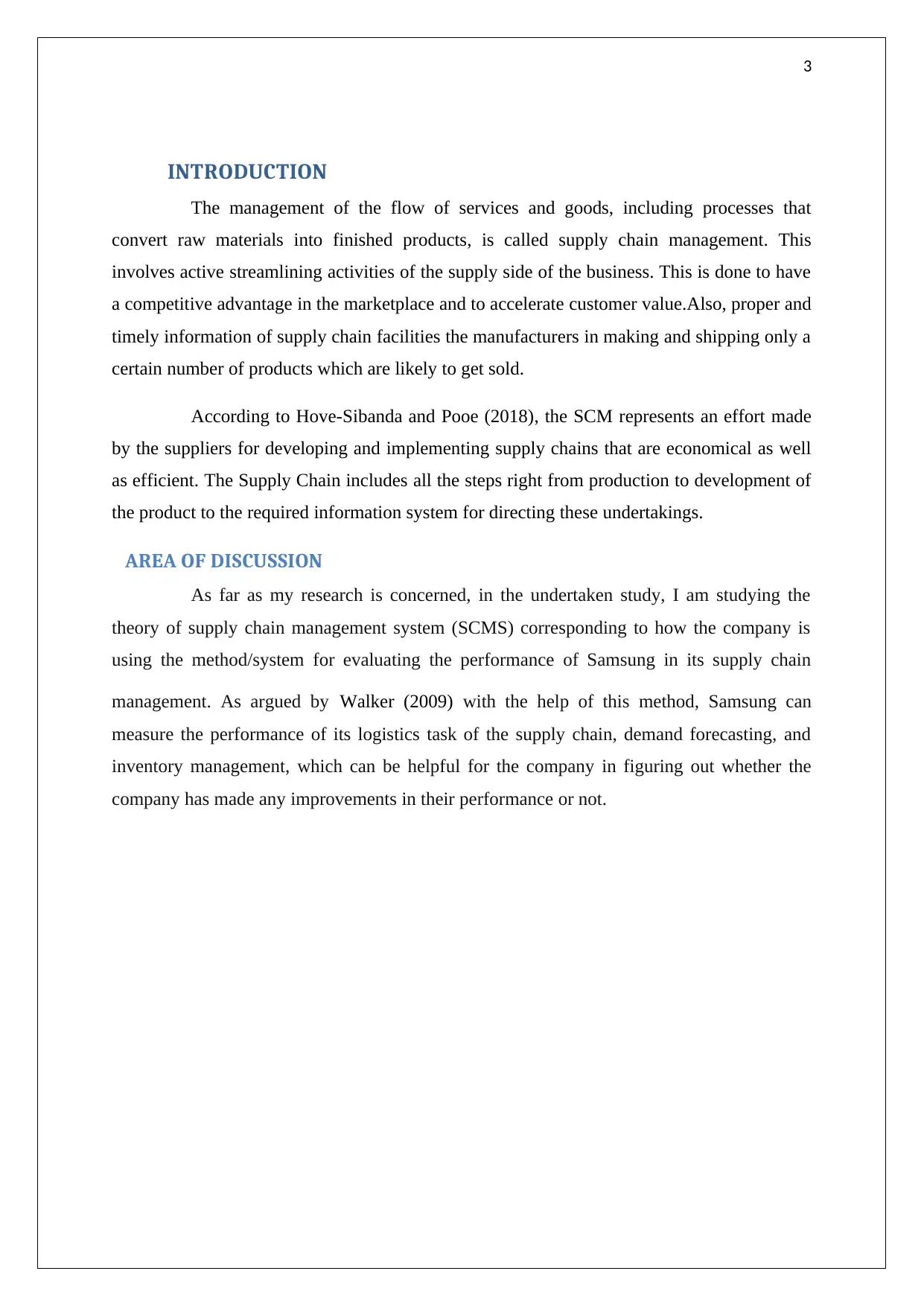
3
INTRODUCTION
The management of the flow of services and goods, including processes that
convert raw materials into finished products, is called supply chain management. This
involves active streamlining activities of the supply side of the business. This is done to have
a competitive advantage in the marketplace and to accelerate customer value.Also, proper and
timely information of supply chain facilities the manufacturers in making and shipping only a
certain number of products which are likely to get sold.
According to Hove-Sibanda and Pooe (2018), the SCM represents an effort made
by the suppliers for developing and implementing supply chains that are economical as well
as efficient. The Supply Chain includes all the steps right from production to development of
the product to the required information system for directing these undertakings.
AREA OF DISCUSSION
As far as my research is concerned, in the undertaken study, I am studying the
theory of supply chain management system (SCMS) corresponding to how the company is
using the method/system for evaluating the performance of Samsung in its supply chain
management. As argued by Walker (2009) with the help of this method, Samsung can
measure the performance of its logistics task of the supply chain, demand forecasting, and
inventory management, which can be helpful for the company in figuring out whether the
company has made any improvements in their performance or not.
INTRODUCTION
The management of the flow of services and goods, including processes that
convert raw materials into finished products, is called supply chain management. This
involves active streamlining activities of the supply side of the business. This is done to have
a competitive advantage in the marketplace and to accelerate customer value.Also, proper and
timely information of supply chain facilities the manufacturers in making and shipping only a
certain number of products which are likely to get sold.
According to Hove-Sibanda and Pooe (2018), the SCM represents an effort made
by the suppliers for developing and implementing supply chains that are economical as well
as efficient. The Supply Chain includes all the steps right from production to development of
the product to the required information system for directing these undertakings.
AREA OF DISCUSSION
As far as my research is concerned, in the undertaken study, I am studying the
theory of supply chain management system (SCMS) corresponding to how the company is
using the method/system for evaluating the performance of Samsung in its supply chain
management. As argued by Walker (2009) with the help of this method, Samsung can
measure the performance of its logistics task of the supply chain, demand forecasting, and
inventory management, which can be helpful for the company in figuring out whether the
company has made any improvements in their performance or not.
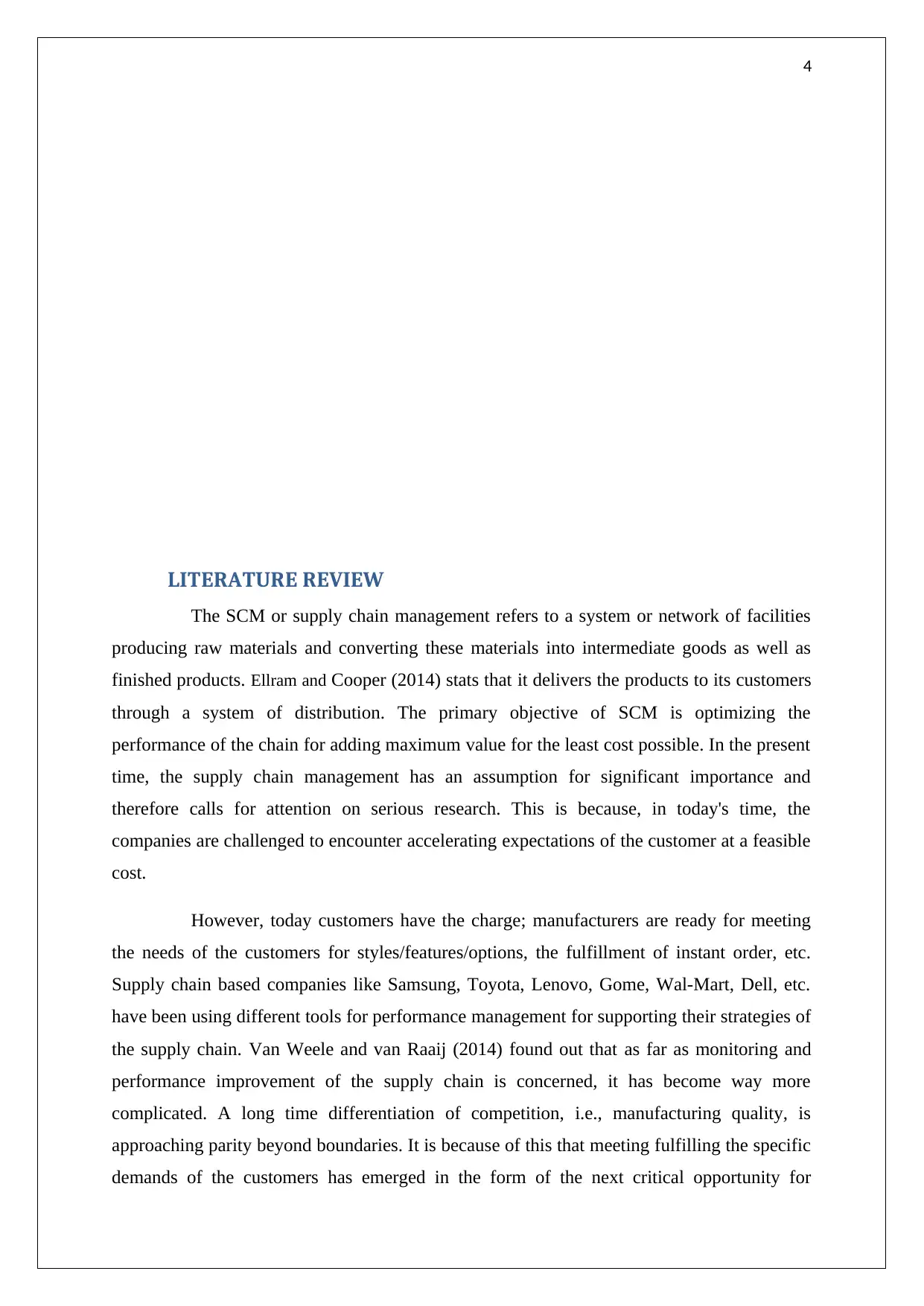
4
LITERATURE REVIEW
The SCM or supply chain management refers to a system or network of facilities
producing raw materials and converting these materials into intermediate goods as well as
finished products. Ellram and Cooper (2014) stats that it delivers the products to its customers
through a system of distribution. The primary objective of SCM is optimizing the
performance of the chain for adding maximum value for the least cost possible. In the present
time, the supply chain management has an assumption for significant importance and
therefore calls for attention on serious research. This is because, in today's time, the
companies are challenged to encounter accelerating expectations of the customer at a feasible
cost.
However, today customers have the charge; manufacturers are ready for meeting
the needs of the customers for styles/features/options, the fulfillment of instant order, etc.
Supply chain based companies like Samsung, Toyota, Lenovo, Gome, Wal-Mart, Dell, etc.
have been using different tools for performance management for supporting their strategies of
the supply chain. Van Weele and van Raaij (2014) found out that as far as monitoring and
performance improvement of the supply chain is concerned, it has become way more
complicated. A long time differentiation of competition, i.e., manufacturing quality, is
approaching parity beyond boundaries. It is because of this that meeting fulfilling the specific
demands of the customers has emerged in the form of the next critical opportunity for
LITERATURE REVIEW
The SCM or supply chain management refers to a system or network of facilities
producing raw materials and converting these materials into intermediate goods as well as
finished products. Ellram and Cooper (2014) stats that it delivers the products to its customers
through a system of distribution. The primary objective of SCM is optimizing the
performance of the chain for adding maximum value for the least cost possible. In the present
time, the supply chain management has an assumption for significant importance and
therefore calls for attention on serious research. This is because, in today's time, the
companies are challenged to encounter accelerating expectations of the customer at a feasible
cost.
However, today customers have the charge; manufacturers are ready for meeting
the needs of the customers for styles/features/options, the fulfillment of instant order, etc.
Supply chain based companies like Samsung, Toyota, Lenovo, Gome, Wal-Mart, Dell, etc.
have been using different tools for performance management for supporting their strategies of
the supply chain. Van Weele and van Raaij (2014) found out that as far as monitoring and
performance improvement of the supply chain is concerned, it has become way more
complicated. A long time differentiation of competition, i.e., manufacturing quality, is
approaching parity beyond boundaries. It is because of this that meeting fulfilling the specific
demands of the customers has emerged in the form of the next critical opportunity for
Secure Best Marks with AI Grader
Need help grading? Try our AI Grader for instant feedback on your assignments.
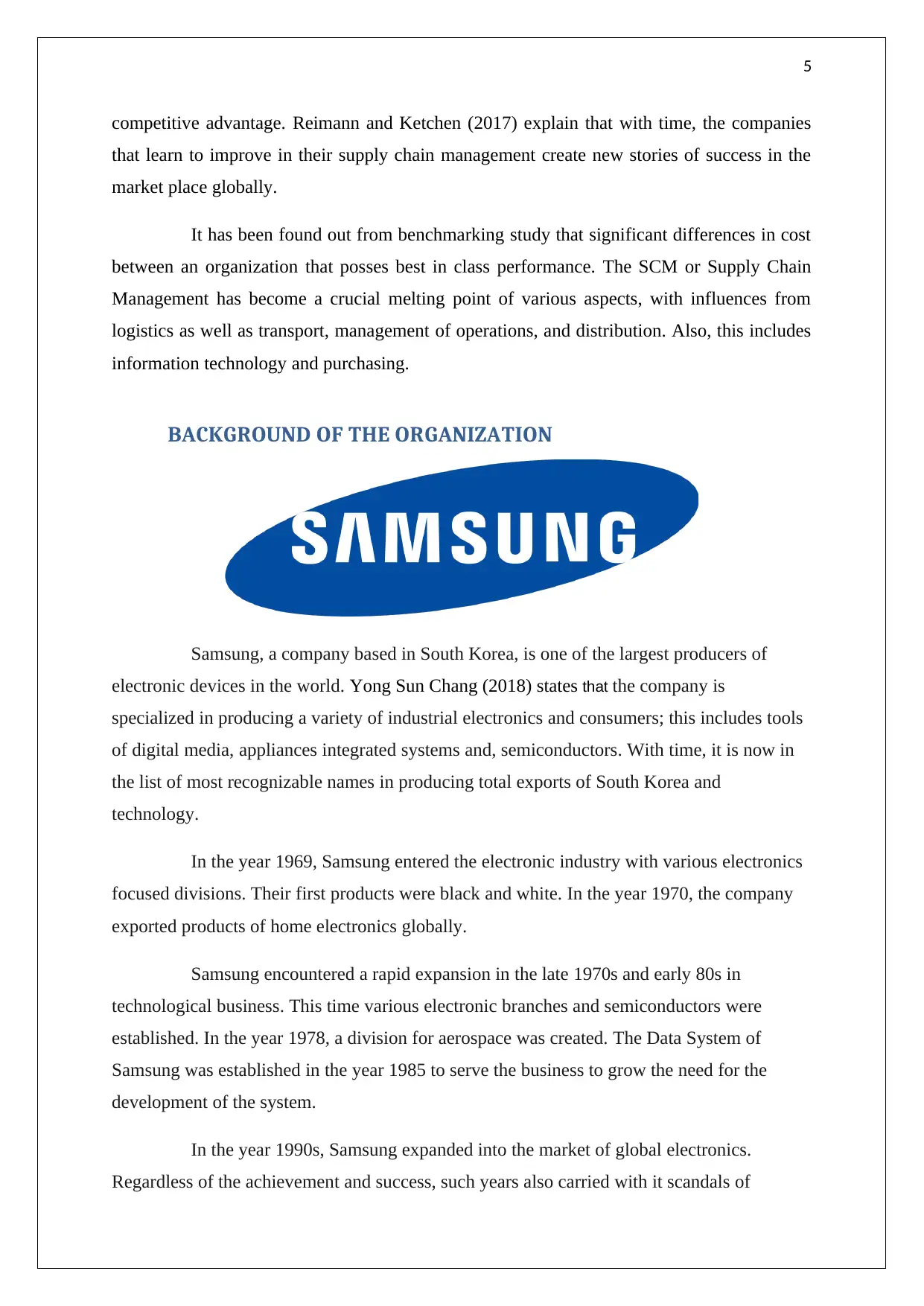
5
competitive advantage. Reimann and Ketchen (2017) explain that with time, the companies
that learn to improve in their supply chain management create new stories of success in the
market place globally.
It has been found out from benchmarking study that significant differences in cost
between an organization that posses best in class performance. The SCM or Supply Chain
Management has become a crucial melting point of various aspects, with influences from
logistics as well as transport, management of operations, and distribution. Also, this includes
information technology and purchasing.
BACKGROUND OF THE ORGANIZATION
Samsung, a company based in South Korea, is one of the largest producers of
electronic devices in the world. Yong Sun Chang (2018) states that the company is
specialized in producing a variety of industrial electronics and consumers; this includes tools
of digital media, appliances integrated systems and, semiconductors. With time, it is now in
the list of most recognizable names in producing total exports of South Korea and
technology.
In the year 1969, Samsung entered the electronic industry with various electronics
focused divisions. Their first products were black and white. In the year 1970, the company
exported products of home electronics globally.
Samsung encountered a rapid expansion in the late 1970s and early 80s in
technological business. This time various electronic branches and semiconductors were
established. In the year 1978, a division for aerospace was created. The Data System of
Samsung was established in the year 1985 to serve the business to grow the need for the
development of the system.
In the year 1990s, Samsung expanded into the market of global electronics.
Regardless of the achievement and success, such years also carried with it scandals of
competitive advantage. Reimann and Ketchen (2017) explain that with time, the companies
that learn to improve in their supply chain management create new stories of success in the
market place globally.
It has been found out from benchmarking study that significant differences in cost
between an organization that posses best in class performance. The SCM or Supply Chain
Management has become a crucial melting point of various aspects, with influences from
logistics as well as transport, management of operations, and distribution. Also, this includes
information technology and purchasing.
BACKGROUND OF THE ORGANIZATION
Samsung, a company based in South Korea, is one of the largest producers of
electronic devices in the world. Yong Sun Chang (2018) states that the company is
specialized in producing a variety of industrial electronics and consumers; this includes tools
of digital media, appliances integrated systems and, semiconductors. With time, it is now in
the list of most recognizable names in producing total exports of South Korea and
technology.
In the year 1969, Samsung entered the electronic industry with various electronics
focused divisions. Their first products were black and white. In the year 1970, the company
exported products of home electronics globally.
Samsung encountered a rapid expansion in the late 1970s and early 80s in
technological business. This time various electronic branches and semiconductors were
established. In the year 1978, a division for aerospace was created. The Data System of
Samsung was established in the year 1985 to serve the business to grow the need for the
development of the system.
In the year 1990s, Samsung expanded into the market of global electronics.
Regardless of the achievement and success, such years also carried with it scandals of
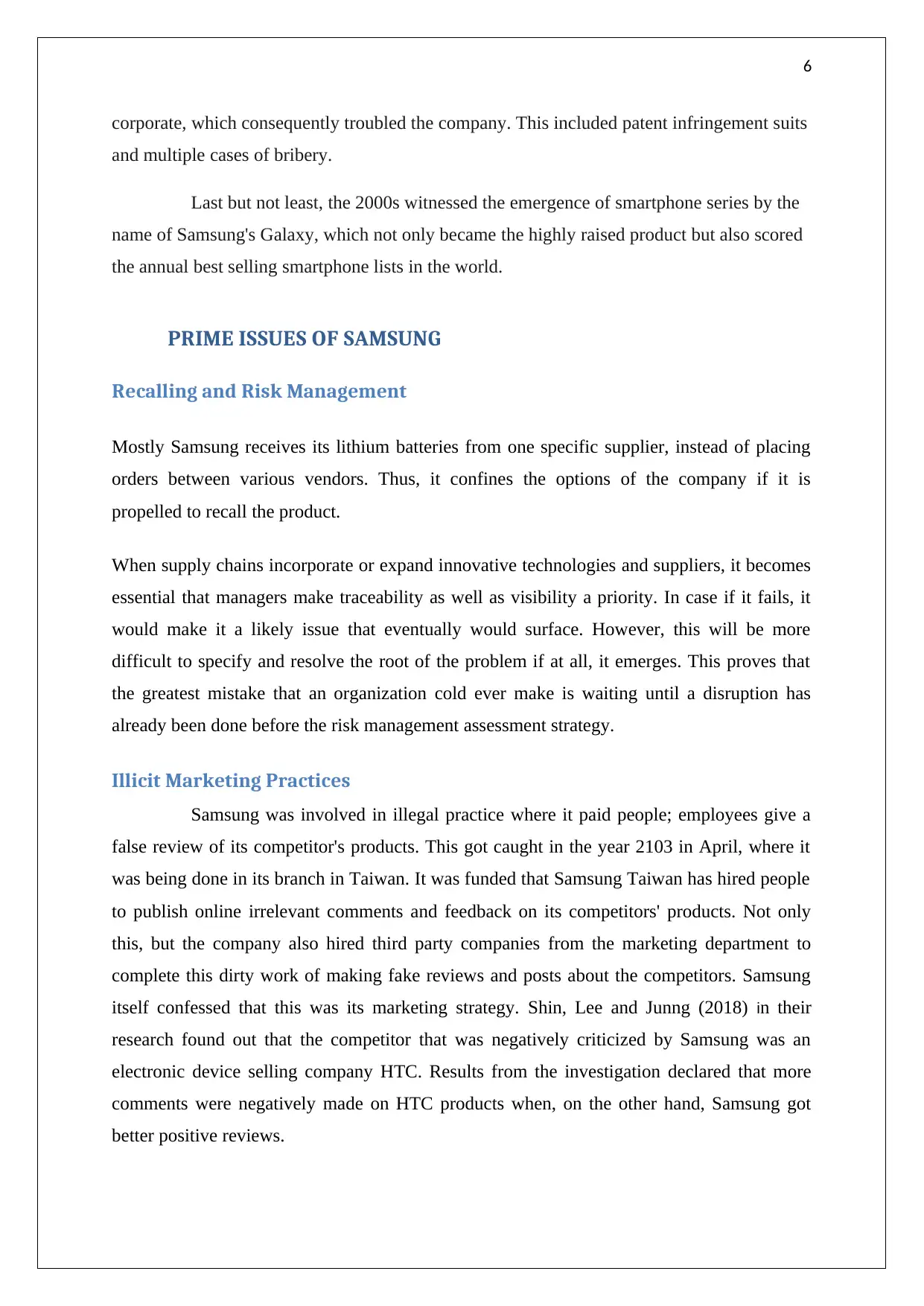
6
corporate, which consequently troubled the company. This included patent infringement suits
and multiple cases of bribery.
Last but not least, the 2000s witnessed the emergence of smartphone series by the
name of Samsung's Galaxy, which not only became the highly raised product but also scored
the annual best selling smartphone lists in the world.
PRIME ISSUES OF SAMSUNG
Recalling and Risk Management
Mostly Samsung receives its lithium batteries from one specific supplier, instead of placing
orders between various vendors. Thus, it confines the options of the company if it is
propelled to recall the product.
When supply chains incorporate or expand innovative technologies and suppliers, it becomes
essential that managers make traceability as well as visibility a priority. In case if it fails, it
would make it a likely issue that eventually would surface. However, this will be more
difficult to specify and resolve the root of the problem if at all, it emerges. This proves that
the greatest mistake that an organization cold ever make is waiting until a disruption has
already been done before the risk management assessment strategy.
Illicit Marketing Practices
Samsung was involved in illegal practice where it paid people; employees give a
false review of its competitor's products. This got caught in the year 2103 in April, where it
was being done in its branch in Taiwan. It was funded that Samsung Taiwan has hired people
to publish online irrelevant comments and feedback on its competitors' products. Not only
this, but the company also hired third party companies from the marketing department to
complete this dirty work of making fake reviews and posts about the competitors. Samsung
itself confessed that this was its marketing strategy. Shin, Lee and Junng (2018) in their
research found out that the competitor that was negatively criticized by Samsung was an
electronic device selling company HTC. Results from the investigation declared that more
comments were negatively made on HTC products when, on the other hand, Samsung got
better positive reviews.
corporate, which consequently troubled the company. This included patent infringement suits
and multiple cases of bribery.
Last but not least, the 2000s witnessed the emergence of smartphone series by the
name of Samsung's Galaxy, which not only became the highly raised product but also scored
the annual best selling smartphone lists in the world.
PRIME ISSUES OF SAMSUNG
Recalling and Risk Management
Mostly Samsung receives its lithium batteries from one specific supplier, instead of placing
orders between various vendors. Thus, it confines the options of the company if it is
propelled to recall the product.
When supply chains incorporate or expand innovative technologies and suppliers, it becomes
essential that managers make traceability as well as visibility a priority. In case if it fails, it
would make it a likely issue that eventually would surface. However, this will be more
difficult to specify and resolve the root of the problem if at all, it emerges. This proves that
the greatest mistake that an organization cold ever make is waiting until a disruption has
already been done before the risk management assessment strategy.
Illicit Marketing Practices
Samsung was involved in illegal practice where it paid people; employees give a
false review of its competitor's products. This got caught in the year 2103 in April, where it
was being done in its branch in Taiwan. It was funded that Samsung Taiwan has hired people
to publish online irrelevant comments and feedback on its competitors' products. Not only
this, but the company also hired third party companies from the marketing department to
complete this dirty work of making fake reviews and posts about the competitors. Samsung
itself confessed that this was its marketing strategy. Shin, Lee and Junng (2018) in their
research found out that the competitor that was negatively criticized by Samsung was an
electronic device selling company HTC. Results from the investigation declared that more
comments were negatively made on HTC products when, on the other hand, Samsung got
better positive reviews.
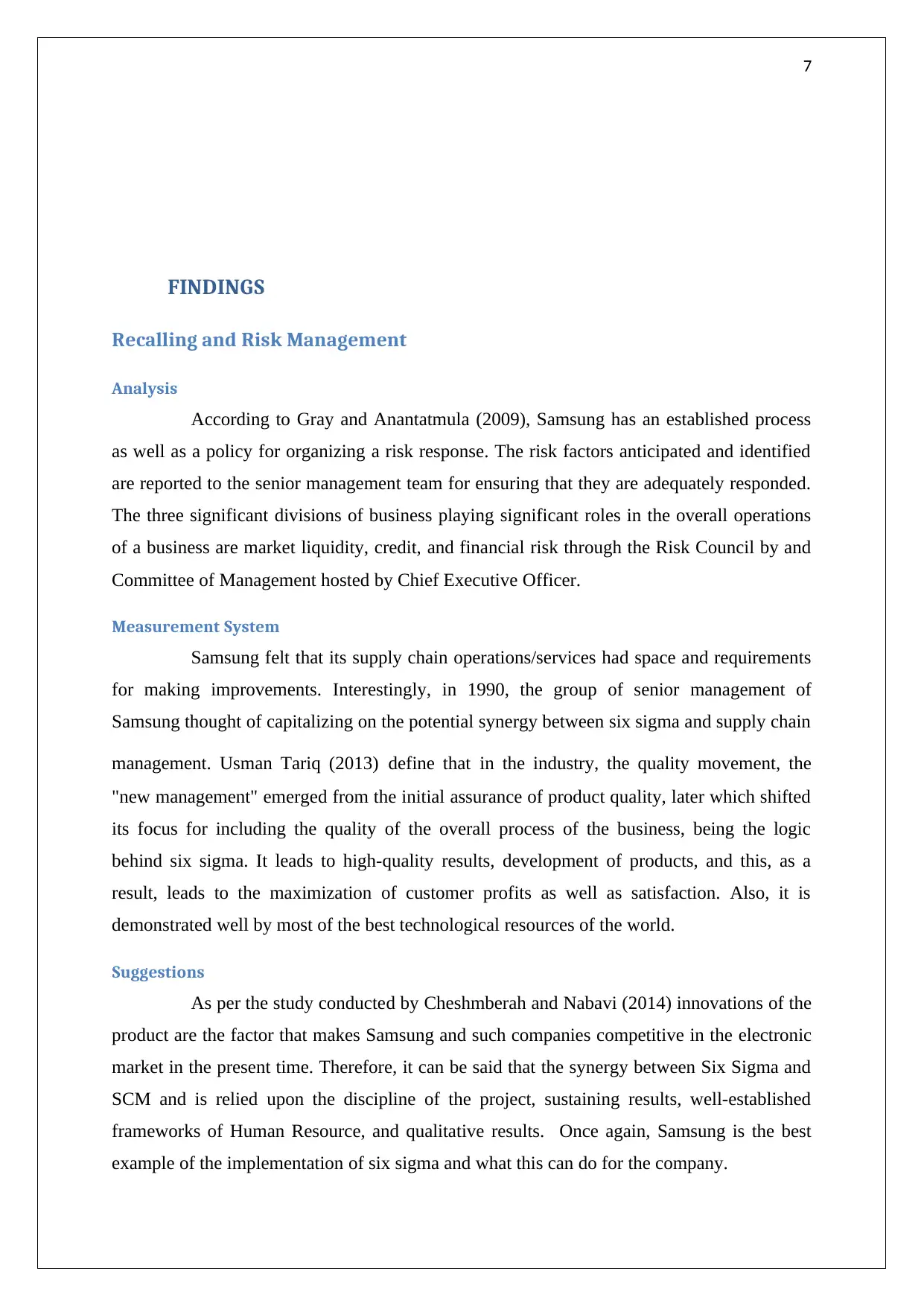
7
FINDINGS
Recalling and Risk Management
Analysis
According to Gray and Anantatmula (2009), Samsung has an established process
as well as a policy for organizing a risk response. The risk factors anticipated and identified
are reported to the senior management team for ensuring that they are adequately responded.
The three significant divisions of business playing significant roles in the overall operations
of a business are market liquidity, credit, and financial risk through the Risk Council by and
Committee of Management hosted by Chief Executive Officer.
Measurement System
Samsung felt that its supply chain operations/services had space and requirements
for making improvements. Interestingly, in 1990, the group of senior management of
Samsung thought of capitalizing on the potential synergy between six sigma and supply chain
management. Usman Tariq (2013) define that in the industry, the quality movement, the
"new management" emerged from the initial assurance of product quality, later which shifted
its focus for including the quality of the overall process of the business, being the logic
behind six sigma. It leads to high-quality results, development of products, and this, as a
result, leads to the maximization of customer profits as well as satisfaction. Also, it is
demonstrated well by most of the best technological resources of the world.
Suggestions
As per the study conducted by Cheshmberah and Nabavi (2014) innovations of the
product are the factor that makes Samsung and such companies competitive in the electronic
market in the present time. Therefore, it can be said that the synergy between Six Sigma and
SCM and is relied upon the discipline of the project, sustaining results, well-established
frameworks of Human Resource, and qualitative results. Once again, Samsung is the best
example of the implementation of six sigma and what this can do for the company.
FINDINGS
Recalling and Risk Management
Analysis
According to Gray and Anantatmula (2009), Samsung has an established process
as well as a policy for organizing a risk response. The risk factors anticipated and identified
are reported to the senior management team for ensuring that they are adequately responded.
The three significant divisions of business playing significant roles in the overall operations
of a business are market liquidity, credit, and financial risk through the Risk Council by and
Committee of Management hosted by Chief Executive Officer.
Measurement System
Samsung felt that its supply chain operations/services had space and requirements
for making improvements. Interestingly, in 1990, the group of senior management of
Samsung thought of capitalizing on the potential synergy between six sigma and supply chain
management. Usman Tariq (2013) define that in the industry, the quality movement, the
"new management" emerged from the initial assurance of product quality, later which shifted
its focus for including the quality of the overall process of the business, being the logic
behind six sigma. It leads to high-quality results, development of products, and this, as a
result, leads to the maximization of customer profits as well as satisfaction. Also, it is
demonstrated well by most of the best technological resources of the world.
Suggestions
As per the study conducted by Cheshmberah and Nabavi (2014) innovations of the
product are the factor that makes Samsung and such companies competitive in the electronic
market in the present time. Therefore, it can be said that the synergy between Six Sigma and
SCM and is relied upon the discipline of the project, sustaining results, well-established
frameworks of Human Resource, and qualitative results. Once again, Samsung is the best
example of the implementation of six sigma and what this can do for the company.
Paraphrase This Document
Need a fresh take? Get an instant paraphrase of this document with our AI Paraphraser
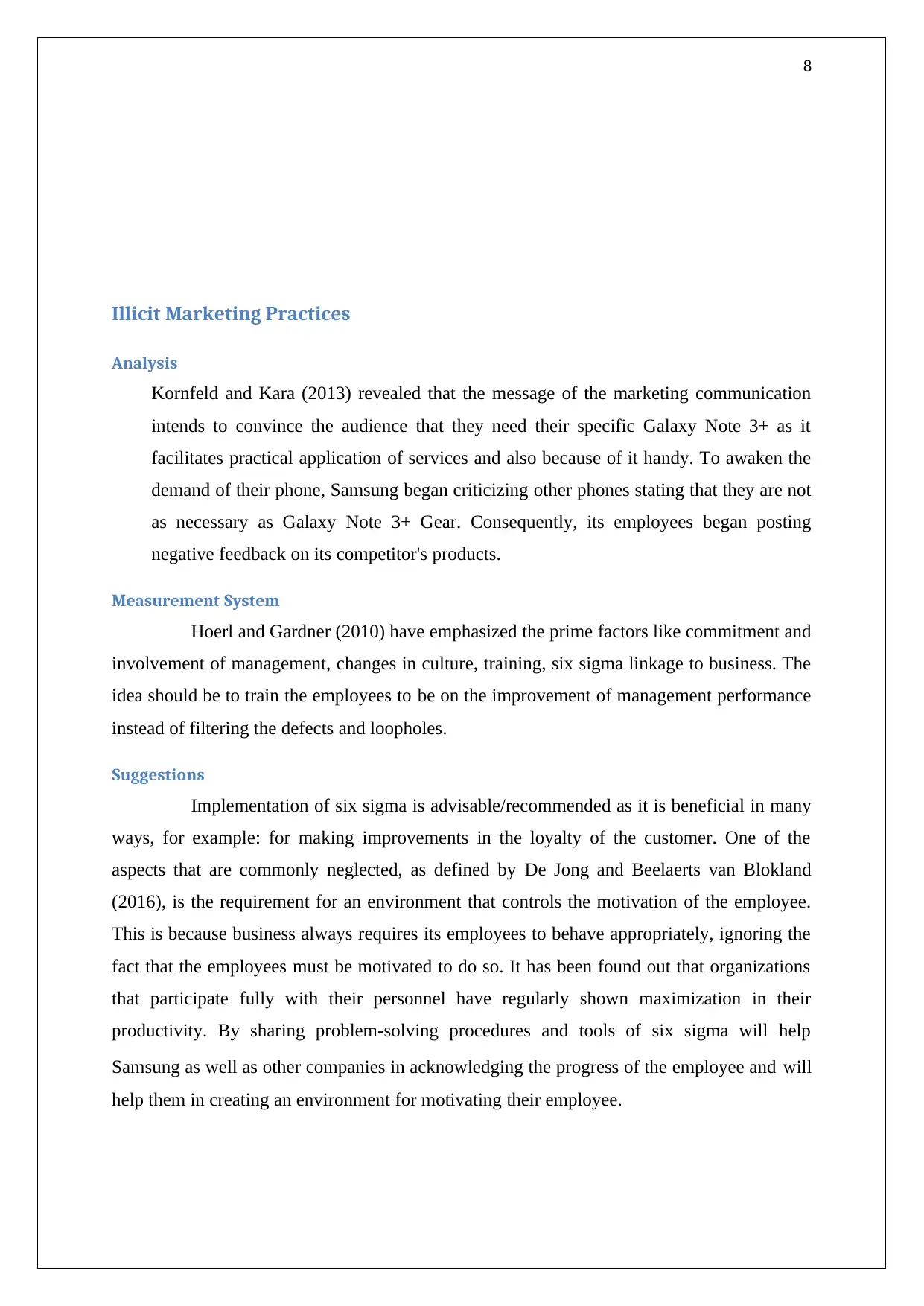
8
Illicit Marketing Practices
Analysis
Kornfeld and Kara (2013) revealed that the message of the marketing communication
intends to convince the audience that they need their specific Galaxy Note 3+ as it
facilitates practical application of services and also because of it handy. To awaken the
demand of their phone, Samsung began criticizing other phones stating that they are not
as necessary as Galaxy Note 3+ Gear. Consequently, its employees began posting
negative feedback on its competitor's products.
Measurement System
Hoerl and Gardner (2010) have emphasized the prime factors like commitment and
involvement of management, changes in culture, training, six sigma linkage to business. The
idea should be to train the employees to be on the improvement of management performance
instead of filtering the defects and loopholes.
Suggestions
Implementation of six sigma is advisable/recommended as it is beneficial in many
ways, for example: for making improvements in the loyalty of the customer. One of the
aspects that are commonly neglected, as defined by De Jong and Beelaerts van Blokland
(2016), is the requirement for an environment that controls the motivation of the employee.
This is because business always requires its employees to behave appropriately, ignoring the
fact that the employees must be motivated to do so. It has been found out that organizations
that participate fully with their personnel have regularly shown maximization in their
productivity. By sharing problem-solving procedures and tools of six sigma will help
Samsung as well as other companies in acknowledging the progress of the employee and will
help them in creating an environment for motivating their employee.
Illicit Marketing Practices
Analysis
Kornfeld and Kara (2013) revealed that the message of the marketing communication
intends to convince the audience that they need their specific Galaxy Note 3+ as it
facilitates practical application of services and also because of it handy. To awaken the
demand of their phone, Samsung began criticizing other phones stating that they are not
as necessary as Galaxy Note 3+ Gear. Consequently, its employees began posting
negative feedback on its competitor's products.
Measurement System
Hoerl and Gardner (2010) have emphasized the prime factors like commitment and
involvement of management, changes in culture, training, six sigma linkage to business. The
idea should be to train the employees to be on the improvement of management performance
instead of filtering the defects and loopholes.
Suggestions
Implementation of six sigma is advisable/recommended as it is beneficial in many
ways, for example: for making improvements in the loyalty of the customer. One of the
aspects that are commonly neglected, as defined by De Jong and Beelaerts van Blokland
(2016), is the requirement for an environment that controls the motivation of the employee.
This is because business always requires its employees to behave appropriately, ignoring the
fact that the employees must be motivated to do so. It has been found out that organizations
that participate fully with their personnel have regularly shown maximization in their
productivity. By sharing problem-solving procedures and tools of six sigma will help
Samsung as well as other companies in acknowledging the progress of the employee and will
help them in creating an environment for motivating their employee.
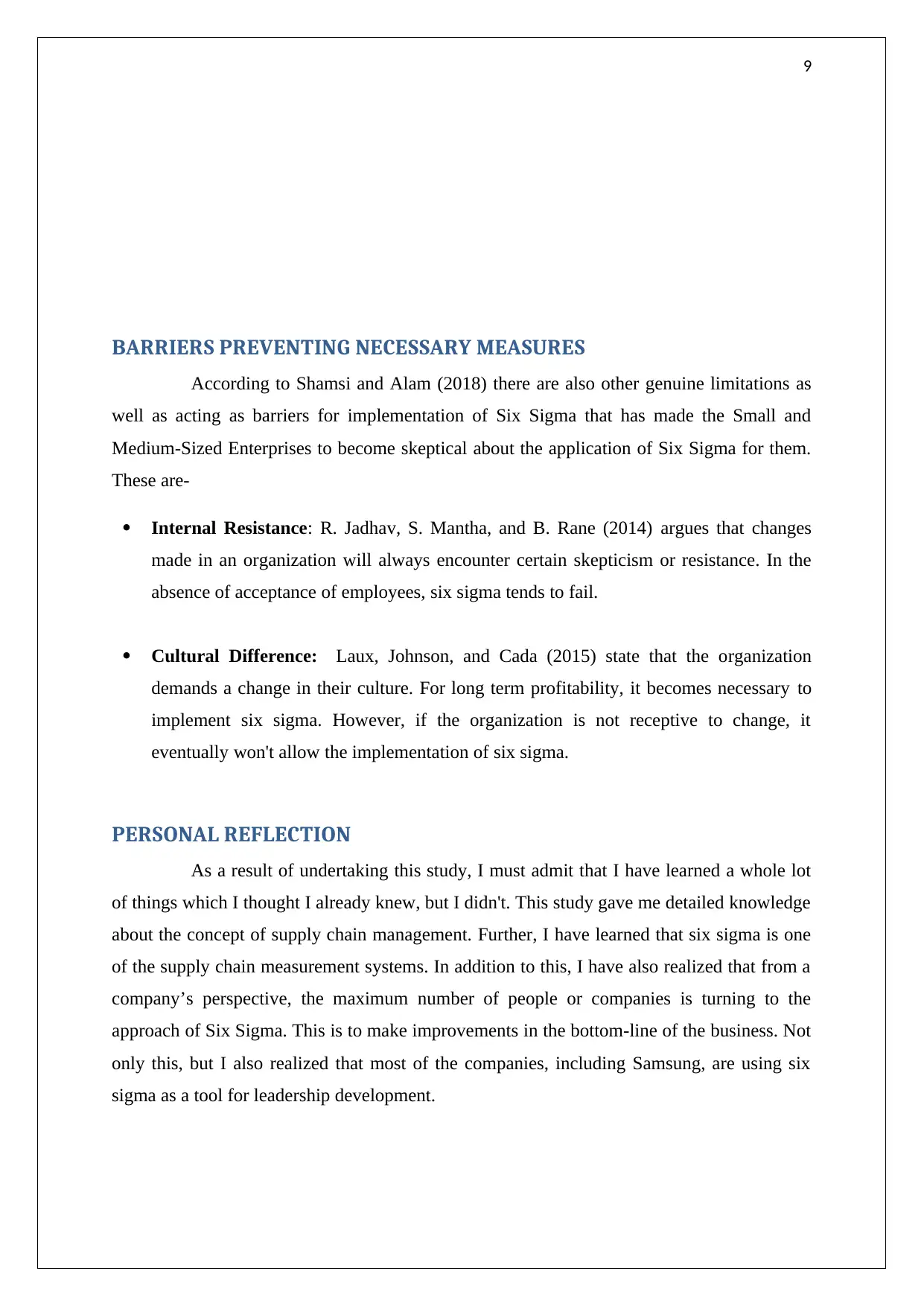
9
BARRIERS PREVENTING NECESSARY MEASURES
According to Shamsi and Alam (2018) there are also other genuine limitations as
well as acting as barriers for implementation of Six Sigma that has made the Small and
Medium-Sized Enterprises to become skeptical about the application of Six Sigma for them.
These are-
Internal Resistance: R. Jadhav, S. Mantha, and B. Rane (2014) argues that changes
made in an organization will always encounter certain skepticism or resistance. In the
absence of acceptance of employees, six sigma tends to fail.
Cultural Difference: Laux, Johnson, and Cada (2015) state that the organization
demands a change in their culture. For long term profitability, it becomes necessary to
implement six sigma. However, if the organization is not receptive to change, it
eventually won't allow the implementation of six sigma.
PERSONAL REFLECTION
As a result of undertaking this study, I must admit that I have learned a whole lot
of things which I thought I already knew, but I didn't. This study gave me detailed knowledge
about the concept of supply chain management. Further, I have learned that six sigma is one
of the supply chain measurement systems. In addition to this, I have also realized that from a
company’s perspective, the maximum number of people or companies is turning to the
approach of Six Sigma. This is to make improvements in the bottom-line of the business. Not
only this, but I also realized that most of the companies, including Samsung, are using six
sigma as a tool for leadership development.
BARRIERS PREVENTING NECESSARY MEASURES
According to Shamsi and Alam (2018) there are also other genuine limitations as
well as acting as barriers for implementation of Six Sigma that has made the Small and
Medium-Sized Enterprises to become skeptical about the application of Six Sigma for them.
These are-
Internal Resistance: R. Jadhav, S. Mantha, and B. Rane (2014) argues that changes
made in an organization will always encounter certain skepticism or resistance. In the
absence of acceptance of employees, six sigma tends to fail.
Cultural Difference: Laux, Johnson, and Cada (2015) state that the organization
demands a change in their culture. For long term profitability, it becomes necessary to
implement six sigma. However, if the organization is not receptive to change, it
eventually won't allow the implementation of six sigma.
PERSONAL REFLECTION
As a result of undertaking this study, I must admit that I have learned a whole lot
of things which I thought I already knew, but I didn't. This study gave me detailed knowledge
about the concept of supply chain management. Further, I have learned that six sigma is one
of the supply chain measurement systems. In addition to this, I have also realized that from a
company’s perspective, the maximum number of people or companies is turning to the
approach of Six Sigma. This is to make improvements in the bottom-line of the business. Not
only this, but I also realized that most of the companies, including Samsung, are using six
sigma as a tool for leadership development.
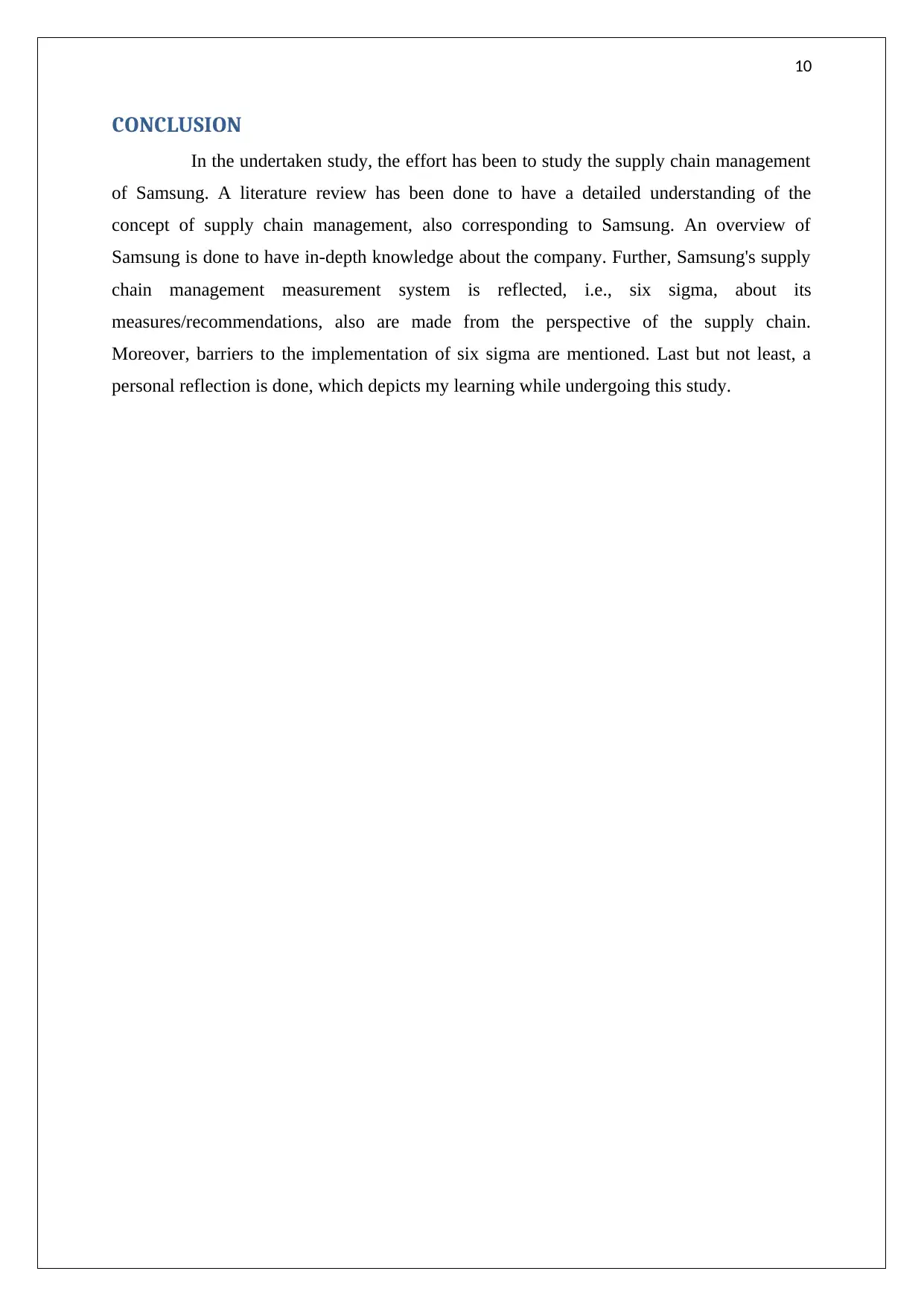
10
CONCLUSION
In the undertaken study, the effort has been to study the supply chain management
of Samsung. A literature review has been done to have a detailed understanding of the
concept of supply chain management, also corresponding to Samsung. An overview of
Samsung is done to have in-depth knowledge about the company. Further, Samsung's supply
chain management measurement system is reflected, i.e., six sigma, about its
measures/recommendations, also are made from the perspective of the supply chain.
Moreover, barriers to the implementation of six sigma are mentioned. Last but not least, a
personal reflection is done, which depicts my learning while undergoing this study.
CONCLUSION
In the undertaken study, the effort has been to study the supply chain management
of Samsung. A literature review has been done to have a detailed understanding of the
concept of supply chain management, also corresponding to Samsung. An overview of
Samsung is done to have in-depth knowledge about the company. Further, Samsung's supply
chain management measurement system is reflected, i.e., six sigma, about its
measures/recommendations, also are made from the perspective of the supply chain.
Moreover, barriers to the implementation of six sigma are mentioned. Last but not least, a
personal reflection is done, which depicts my learning while undergoing this study.
Secure Best Marks with AI Grader
Need help grading? Try our AI Grader for instant feedback on your assignments.
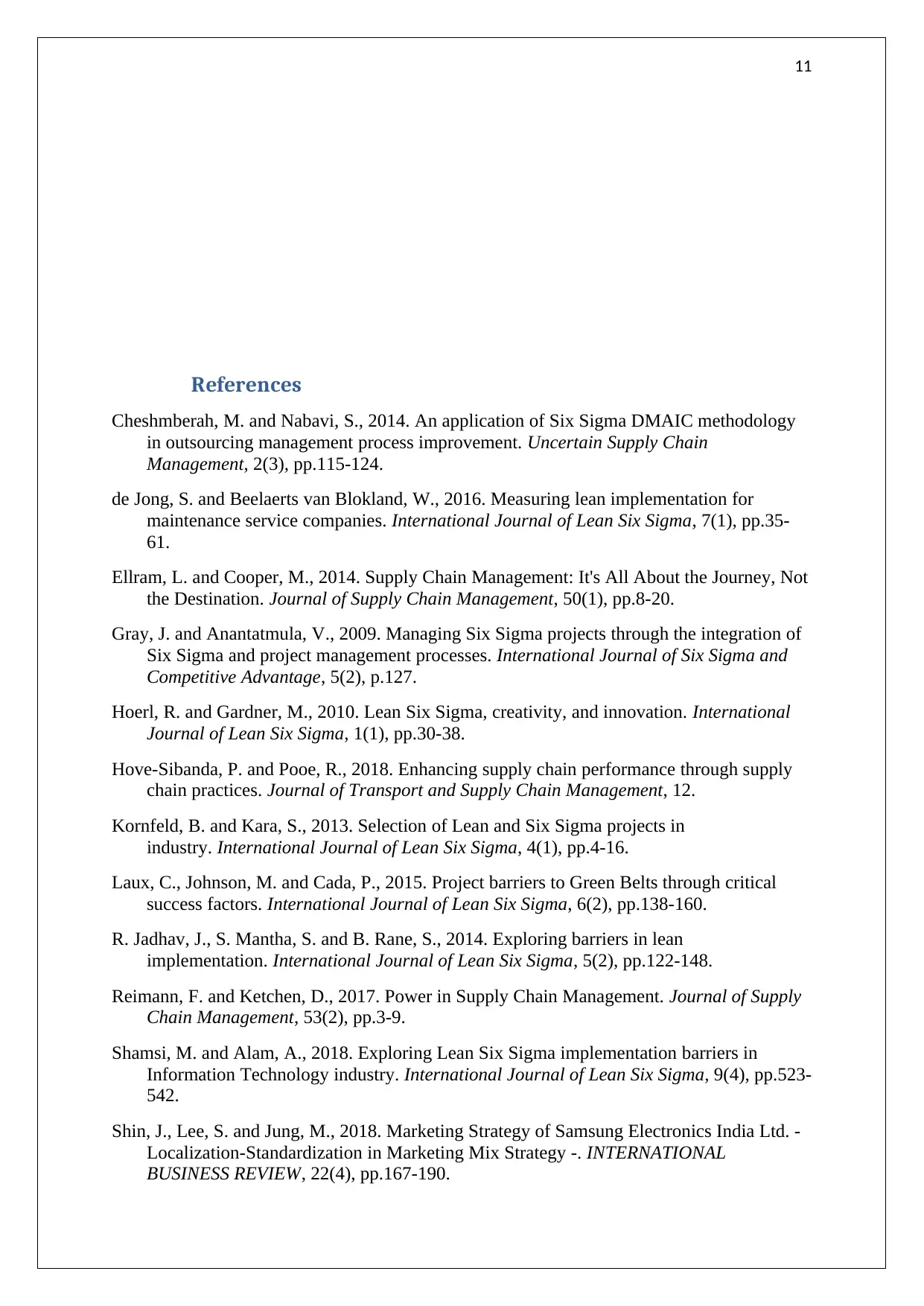
11
References
Cheshmberah, M. and Nabavi, S., 2014. An application of Six Sigma DMAIC methodology
in outsourcing management process improvement. Uncertain Supply Chain
Management, 2(3), pp.115-124.
de Jong, S. and Beelaerts van Blokland, W., 2016. Measuring lean implementation for
maintenance service companies. International Journal of Lean Six Sigma, 7(1), pp.35-
61.
Ellram, L. and Cooper, M., 2014. Supply Chain Management: It's All About the Journey, Not
the Destination. Journal of Supply Chain Management, 50(1), pp.8-20.
Gray, J. and Anantatmula, V., 2009. Managing Six Sigma projects through the integration of
Six Sigma and project management processes. International Journal of Six Sigma and
Competitive Advantage, 5(2), p.127.
Hoerl, R. and Gardner, M., 2010. Lean Six Sigma, creativity, and innovation. International
Journal of Lean Six Sigma, 1(1), pp.30-38.
Hove-Sibanda, P. and Pooe, R., 2018. Enhancing supply chain performance through supply
chain practices. Journal of Transport and Supply Chain Management, 12.
Kornfeld, B. and Kara, S., 2013. Selection of Lean and Six Sigma projects in
industry. International Journal of Lean Six Sigma, 4(1), pp.4-16.
Laux, C., Johnson, M. and Cada, P., 2015. Project barriers to Green Belts through critical
success factors. International Journal of Lean Six Sigma, 6(2), pp.138-160.
R. Jadhav, J., S. Mantha, S. and B. Rane, S., 2014. Exploring barriers in lean
implementation. International Journal of Lean Six Sigma, 5(2), pp.122-148.
Reimann, F. and Ketchen, D., 2017. Power in Supply Chain Management. Journal of Supply
Chain Management, 53(2), pp.3-9.
Shamsi, M. and Alam, A., 2018. Exploring Lean Six Sigma implementation barriers in
Information Technology industry. International Journal of Lean Six Sigma, 9(4), pp.523-
542.
Shin, J., Lee, S. and Jung, M., 2018. Marketing Strategy of Samsung Electronics India Ltd. -
Localization-Standardization in Marketing Mix Strategy -. INTERNATIONAL
BUSINESS REVIEW, 22(4), pp.167-190.
References
Cheshmberah, M. and Nabavi, S., 2014. An application of Six Sigma DMAIC methodology
in outsourcing management process improvement. Uncertain Supply Chain
Management, 2(3), pp.115-124.
de Jong, S. and Beelaerts van Blokland, W., 2016. Measuring lean implementation for
maintenance service companies. International Journal of Lean Six Sigma, 7(1), pp.35-
61.
Ellram, L. and Cooper, M., 2014. Supply Chain Management: It's All About the Journey, Not
the Destination. Journal of Supply Chain Management, 50(1), pp.8-20.
Gray, J. and Anantatmula, V., 2009. Managing Six Sigma projects through the integration of
Six Sigma and project management processes. International Journal of Six Sigma and
Competitive Advantage, 5(2), p.127.
Hoerl, R. and Gardner, M., 2010. Lean Six Sigma, creativity, and innovation. International
Journal of Lean Six Sigma, 1(1), pp.30-38.
Hove-Sibanda, P. and Pooe, R., 2018. Enhancing supply chain performance through supply
chain practices. Journal of Transport and Supply Chain Management, 12.
Kornfeld, B. and Kara, S., 2013. Selection of Lean and Six Sigma projects in
industry. International Journal of Lean Six Sigma, 4(1), pp.4-16.
Laux, C., Johnson, M. and Cada, P., 2015. Project barriers to Green Belts through critical
success factors. International Journal of Lean Six Sigma, 6(2), pp.138-160.
R. Jadhav, J., S. Mantha, S. and B. Rane, S., 2014. Exploring barriers in lean
implementation. International Journal of Lean Six Sigma, 5(2), pp.122-148.
Reimann, F. and Ketchen, D., 2017. Power in Supply Chain Management. Journal of Supply
Chain Management, 53(2), pp.3-9.
Shamsi, M. and Alam, A., 2018. Exploring Lean Six Sigma implementation barriers in
Information Technology industry. International Journal of Lean Six Sigma, 9(4), pp.523-
542.
Shin, J., Lee, S. and Jung, M., 2018. Marketing Strategy of Samsung Electronics India Ltd. -
Localization-Standardization in Marketing Mix Strategy -. INTERNATIONAL
BUSINESS REVIEW, 22(4), pp.167-190.
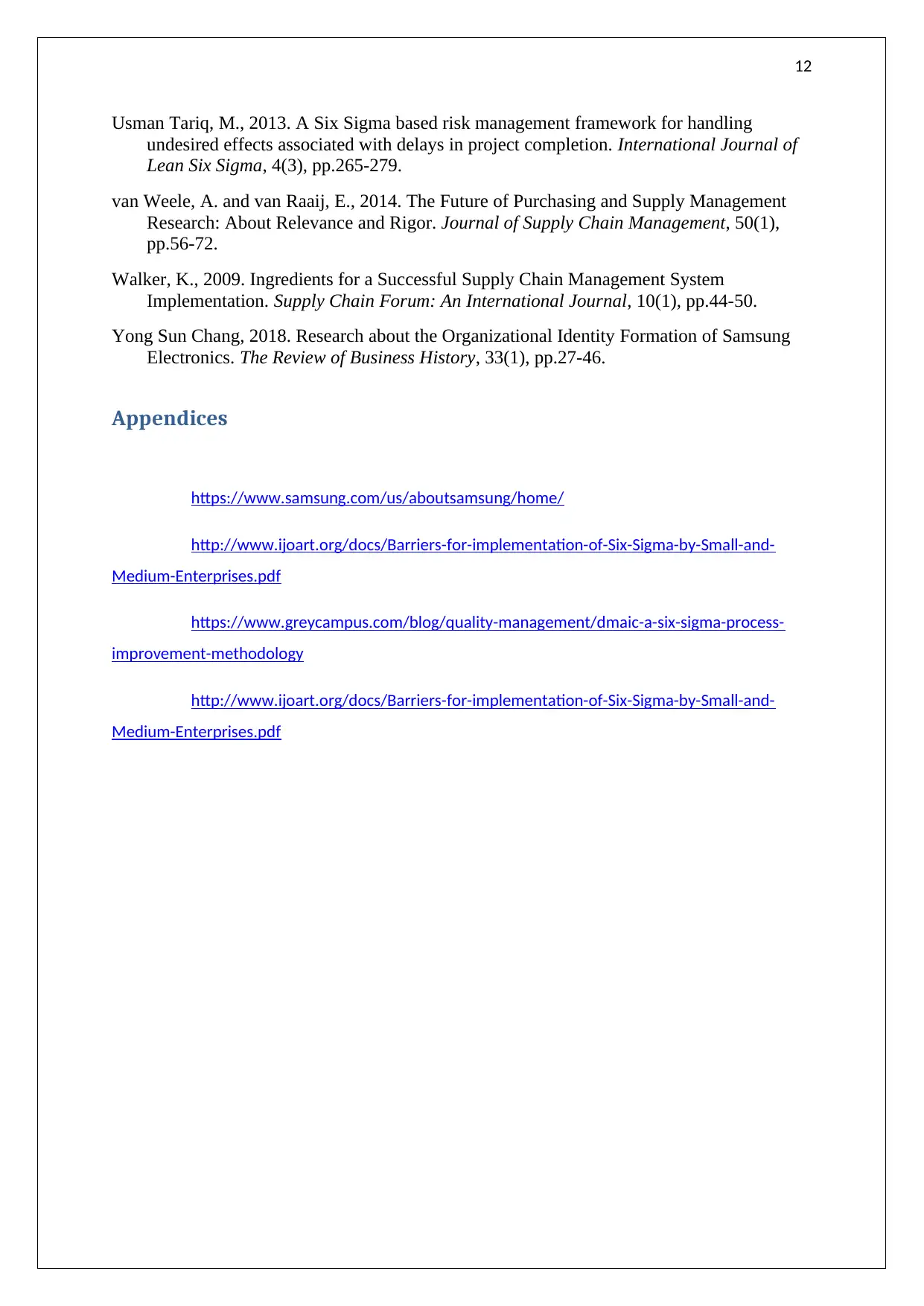
12
Usman Tariq, M., 2013. A Six Sigma based risk management framework for handling
undesired effects associated with delays in project completion. International Journal of
Lean Six Sigma, 4(3), pp.265-279.
van Weele, A. and van Raaij, E., 2014. The Future of Purchasing and Supply Management
Research: About Relevance and Rigor. Journal of Supply Chain Management, 50(1),
pp.56-72.
Walker, K., 2009. Ingredients for a Successful Supply Chain Management System
Implementation. Supply Chain Forum: An International Journal, 10(1), pp.44-50.
Yong Sun Chang, 2018. Research about the Organizational Identity Formation of Samsung
Electronics. The Review of Business History, 33(1), pp.27-46.
Appendices
https://www.samsung.com/us/aboutsamsung/home/
http://www.ijoart.org/docs/Barriers-for-implementation-of-Six-Sigma-by-Small-and-
Medium-Enterprises.pdf
https://www.greycampus.com/blog/quality-management/dmaic-a-six-sigma-process-
improvement-methodology
http://www.ijoart.org/docs/Barriers-for-implementation-of-Six-Sigma-by-Small-and-
Medium-Enterprises.pdf
Usman Tariq, M., 2013. A Six Sigma based risk management framework for handling
undesired effects associated with delays in project completion. International Journal of
Lean Six Sigma, 4(3), pp.265-279.
van Weele, A. and van Raaij, E., 2014. The Future of Purchasing and Supply Management
Research: About Relevance and Rigor. Journal of Supply Chain Management, 50(1),
pp.56-72.
Walker, K., 2009. Ingredients for a Successful Supply Chain Management System
Implementation. Supply Chain Forum: An International Journal, 10(1), pp.44-50.
Yong Sun Chang, 2018. Research about the Organizational Identity Formation of Samsung
Electronics. The Review of Business History, 33(1), pp.27-46.
Appendices
https://www.samsung.com/us/aboutsamsung/home/
http://www.ijoart.org/docs/Barriers-for-implementation-of-Six-Sigma-by-Small-and-
Medium-Enterprises.pdf
https://www.greycampus.com/blog/quality-management/dmaic-a-six-sigma-process-
improvement-methodology
http://www.ijoart.org/docs/Barriers-for-implementation-of-Six-Sigma-by-Small-and-
Medium-Enterprises.pdf
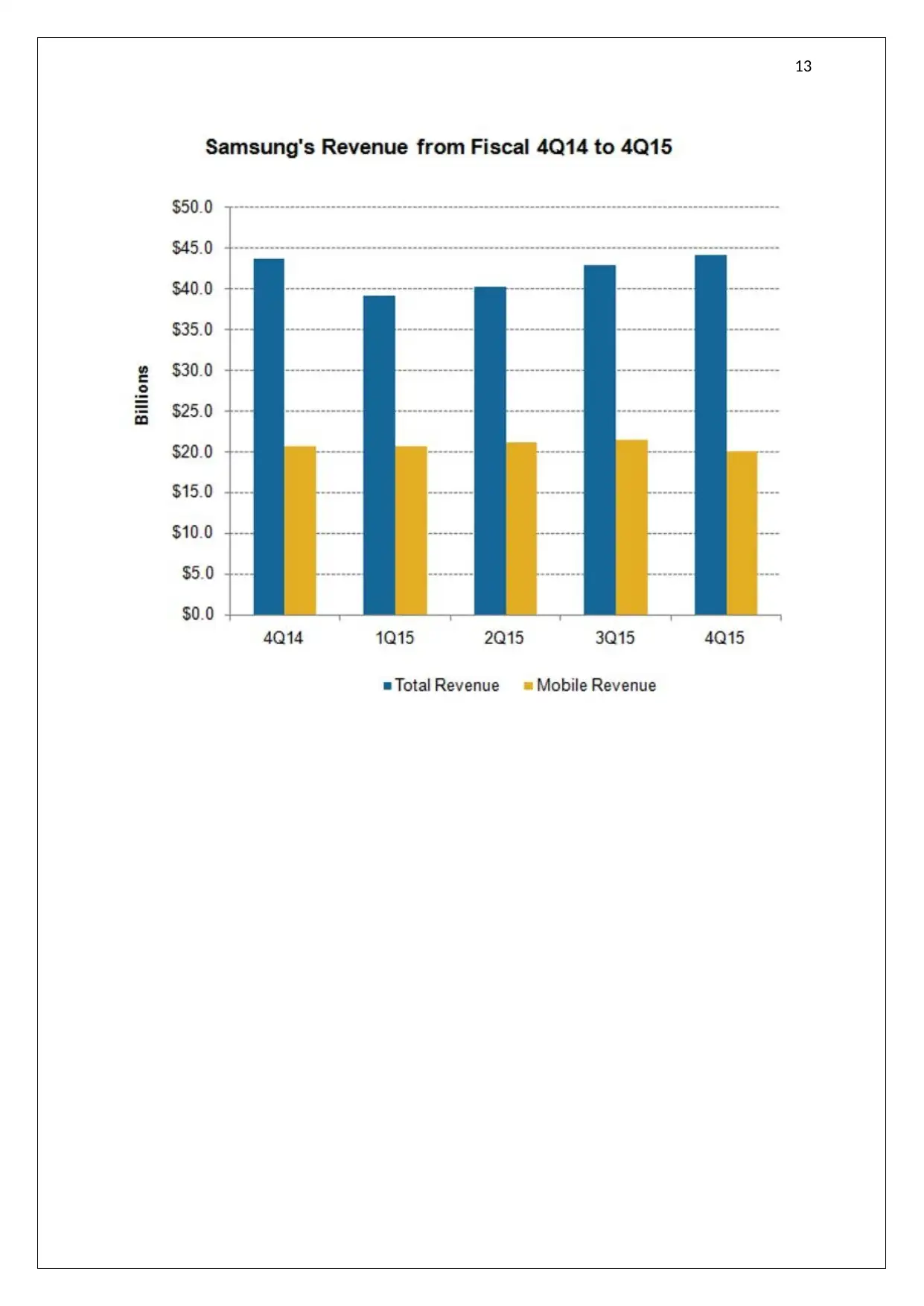
13
1 out of 13
Related Documents
Your All-in-One AI-Powered Toolkit for Academic Success.
+13062052269
info@desklib.com
Available 24*7 on WhatsApp / Email
![[object Object]](/_next/static/media/star-bottom.7253800d.svg)
Unlock your academic potential
© 2024 | Zucol Services PVT LTD | All rights reserved.





